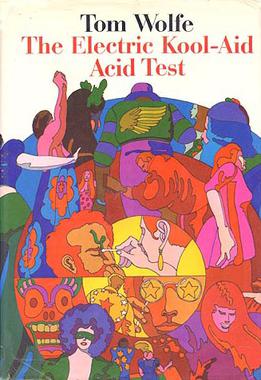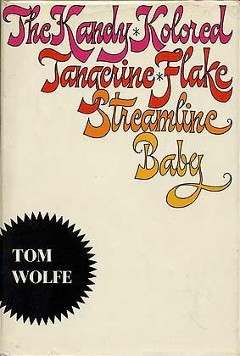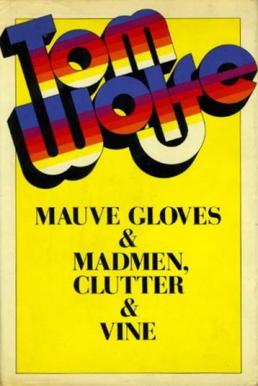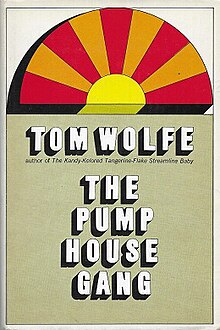
Thomas Kennerly Wolfe Jr. was an American author and journalist widely known for his association with New Journalism, a style of news writing and journalism developed in the 1960s and 1970s that incorporated literary techniques. Much of Wolfe's work was satirical and centred on the counterculture of the 1960s and issues related to class, social status, and the lifestyles of the economic and intellectual elites of New York City.

The Electric Kool-Aid Acid Test is a 1968 nonfiction book by Tom Wolfe. The book is an example of the New Journalism literary style. By 1970, this style had become established as Gonzo Journalism, a term coined in 1970 for the work of Hunter S. Thompson, although Wolfe was already a pioneer in the field. The book presents a firsthand account of the experiences of Ken Kesey and a group of psychedelic enthusiasts, known as the Merry Pranksters, who traveled across the United States in a colorfully-painted school bus they called Furthur. Kesey and the Pranksters became famous for their use of psychedelic drugs to achieve expansion of their consciousness. The book chronicles the Acid Tests and encounters with notable figures of the time, and describes Kesey's exile to Mexico and his arrests.

Furthur is a 1939 International Harvester school bus purchased by author Ken Kesey in 1964 to carry his "Merry Band of Pranksters" cross-country, filming their counterculture adventures as they went. The bus featured prominently in Tom Wolfe's 1968 book The Electric Kool-Aid Acid Test but, due to the chaos of the trip and editing difficulties, footage of the journey was not released as a film until the 2011 documentary Magic Trip.
New Journalism is a style of news writing and journalism, developed in the 1960s and 1970s, that uses literary techniques unconventional at the time. It is characterized by a subjective perspective, a literary style reminiscent of long-form non-fiction. Using extensive imagery, reporters interpolate subjective language within facts whilst immersing themselves in the stories as they reported and wrote them. In traditional journalism, the journalist is "invisible"; facts are meant to be reported objectively.
Carolyn Elizabeth Garcia, also known as "Mountain Girl", is an American Merry Prankster and the former wife of Jerry Garcia, the lead vocalist and guitar player with the band Grateful Dead.
Clay Schuette Felker was an American magazine editor and journalist who co-founded New York magazine in 1968 and California magazine in 1976. He was known for bringing numerous journalists into the profession. The New York Times wrote in 1995, "Few journalists have left a more enduring imprint on late 20th-century journalism—an imprint that was unabashedly mimicked even as it was being mocked—than Clay Felker."

The Kandy-Kolored Tangerine-Flake Streamline Baby is the title of Tom Wolfe's first collected book of essays, published in 1965. The book is named for one of the stories in the collection that was originally published in Esquire magazine in 1963 under the title "There Goes That Kandy-Kolored (Thphhhhhh!) Tangerine-Flake Streamline Baby (Rahghhh!) Around the Bend (Brummmmmmmmmmmmmmm)…" Wolfe's essay for Esquire and this, his first book, are frequently hailed as early examples of New Journalism.
Jane Holzer, is an American art collector and film producer who was previously an actress, model, and Warhol superstar. She was often known by the nickname Baby Jane Holzer. She was also known as a 1960s fashion icon.
John Duncan "Jack" Macpherson III was a former mailman and bartender in San Diego, California. According to his Los Angeles Times obituary, he was a local legend who acquired "a permanent niche in the history of Southern California beach culture".
The non-fiction novel is a literary genre that, broadly speaking, depicts non-fictional elements, such as real historical figures and actual events, woven together with fictitious conversations and uses the storytelling techniques of fiction. The non-fiction novel is an otherwise loosely defined and flexible genre. The genre is sometimes referred to using the slang term "faction", a portmanteau of the words fact and fiction.

Sometimes a Great Notion is the second novel by American author Ken Kesey, published in 1964. While One Flew Over the Cuckoo's Nest (1962) is more famous, many critics consider Sometimes a Great Notion Kesey's magnum opus. The story involves an Oregon family of gyppo loggers who cut trees for a local mill in opposition to unionized workers who are on strike.

The Last American Hero is a 1973 American sports drama film based on the true story of NASCAR driver Junior Johnson. Directed by Lamont Johnson, the film stars Jeff Bridges as Junior Johnson, a character based on Johnson. It is based on Tom Wolfe's essay "The Last American Hero Is Junior Johnson. Yes!", which was first published in Esquire magazine in March 1965 and included in his debut collection of essays, The Kandy-Kolored Tangerine-Flake Streamline Baby, later that year.

The Acid Tests were a series of parties held by author Ken Kesey primarily in the San Francisco Bay Area during the mid-1960s, centered on the use of and advocacy for the psychedelic drug LSD, commonly known as "acid". LSD was not made illegal in California until October 6, 1966.

Mauve Gloves & Madmen, Clutter & Vine is a 1976 book by Tom Wolfe, consisting of eleven essays and one short story that Wolfe wrote between 1967 and 1976. It includes the essay in which he coined the term "the 'Me' Decade" to refer to the 1970s. In addition to the stories, Wolfe also illustrated the book.
"Stalking the Billion-Footed Beast" is an essay by Tom Wolfe that appeared in the November 1989 issue of Harper's Magazine criticizing the American literary establishment for retreating from realism.

Back to Blood is Tom Wolfe's fourth and final novel, published in 2012 by Little, Brown. The novel, set in Miami, Florida, focuses on the subject of Cuban immigrants there.
"Drinking the Kool-Aid" is most strongly believing and accepting in a deadly, deranged, or foolish ideology or concept based only upon the overpowering coaxing of another; the expression is also used to refer to a person who wrongly has faith in a possibly doomed or dangerous idea because of perceived potential high rewards. The phrase typically carries a negative connotation. It can also be used ironically or humorously to refer to accepting an idea or changing a preference due to popularity, peer pressure, or persuasion. In recent years, it has evolved further to mean extreme dedication to a cause or purpose, so extreme that one would "drink the Kool-Aid" and die for the cause.
Boyd and Wain is an acoustic duo composed of American singer songwriter Katy Boyd and English violinist Benny Wain.
Cool Breeze may refer to any of the following:
Byron Dobell was an American editor and artist. He is considered "one of the most respected and accomplished editors in New York magazine publishing history," the editor of several popular American magazines, including American Heritage and Esquire. He is credited with helping the early careers of many writers such as Tom Wolfe, David Halberstam and Mario Puzo. In 1998, Dobell was inducted into the American Society of Magazine Editors Hall of Fame.









